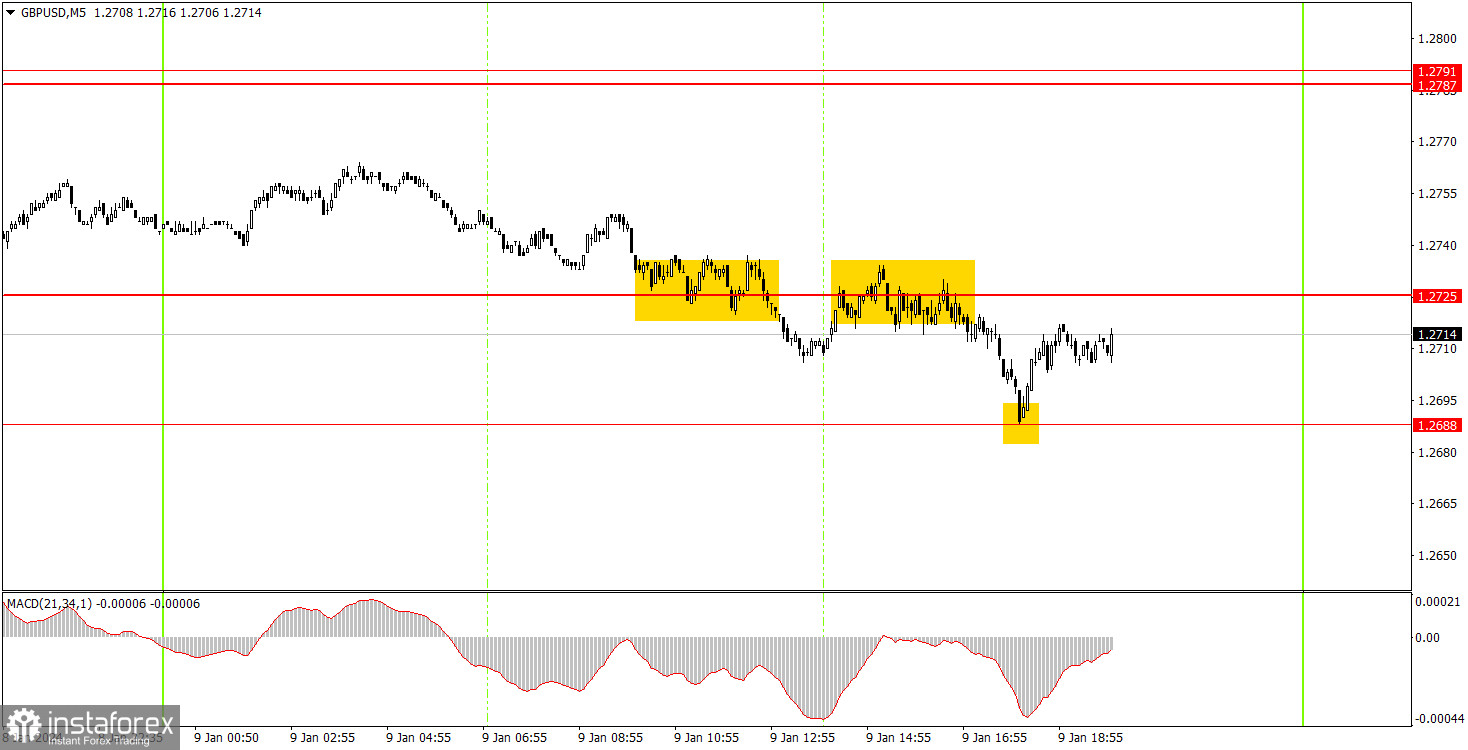Analyzing Tuesday's trades:
GBP/USD on 1H chart

GBP/USD edged down at the end of Tuesday. This was not caused by fundamental or macroeconomic factors. Therefore, the pair has been moving within a wide sideways channel for several weeks (clearly seen on the 4-hour time frame), but on the hourly chart, these movements appear as small trends. Currently, the price has been showing more bullish bias for several days, but in the next few days, it may head towards the 1.2613 level once again.
Despite the three-week flat movement, the British pound continues to hover near its 5-month highs. We have repeatedly mentioned that we don't see any reason for the pound to sustain its growth, but the market still insists on buying the pound rather than the dollar. Lately, market expectations regarding the first Federal Reserve rate cut in March have begun to weaken, so theoretically, the dollar should receive support in the near future. However, we expect a much more significant drop in the price than for it to just fall to the 1.2613 level.
GBP/USD on 5M chart

Only three trading signals were generated on the 5-minute timeframe. The pair initially broke through the level of 1.2725, then bounced off it from below (a duplicate signal), and finally, it reached the level of 1.2688. Beginners could open a short position for the first two trading signals, which brought a profit of about 15 pips. The bounce from 1.2688 could also be traded with a long position, which brought another 15 pips. Volatility was not very high, so the signals weren't the best, and the profit was small.
Trading tips on Wednesday:
On the hourly chart, GBP/USD broke the trendline and now, for the first time in a long while, has a real chance of forming a new downtrend. However, traders have not been able to break through the 1.2611 level in three attempts, so the downward movement was postponed once again. Currently, the pound is rising without a clear reason.
On Wednesday, one can expect a bounce from the short-term trendline, after that we may consider long positions with 1.2787 as a target. We still remain skeptical about the pound's rise, but if there is a corresponding technical signal, why not trade it? A consolidation below the trendline will allow us to consider short positions with a target of 1.2611.
The key levels on the 5M chart are 1.2270, 1.2310, 1.2372-1.2387, 1.2457, 1.2502, 1.2544, 1.2605-1.2611, 1.2688, 1.2725, 1.2787-1.2791, 1.2848-1.2860, 1.2913, 1.2981-1.2993. On Wednesday, Bank of England Governor Andrew Bailey will speak. There are quite a few questions about monetary policy, so Bailey's statements may have a strong impact on the market and the British pound.
Basic trading rules:
1) Signal strength is determined by the time taken for its formation (either a bounce or level breach). A shorter formation time indicates a stronger signal.
2) If two or more trades around a certain level are initiated based on false signals, subsequent signals from that level should be disregarded.
3) In a flat market, any currency pair can produce multiple false signals or none at all. In any case, the flat trend is not the best condition for trading.
4) Trading activities are confined between the onset of the European session and mid-way through the U.S. session, after which all open trades should be manually closed.
5) On the 30-minute timeframe, trades based on MACD signals are only advisable amidst substantial volatility and an established trend, confirmed either by a trendline or trend channel.
6) If two levels lie closely together (ranging from 5 to 15 pips apart), they should be considered as a support or resistance zone.
How to read charts:
Support and Resistance price levels can serve as targets when buying or selling. You can place Take Profit levels near them.
Red lines represent channels or trend lines, depicting the current market trend and indicating the preferable trading direction.
The MACD(14,22,3) indicator, encompassing both the histogram and signal line, acts as an auxiliary tool and can also be used as a signal source.
Significant speeches and reports (always noted in the news calendar) can profoundly influence the price dynamics. Hence, trading during their release calls for heightened caution. It may be reasonable to exit the market to prevent abrupt price reversals against the prevailing trend.
Beginners should always remember that not every trade will yield profit. Establishing a clear strategy coupled with sound money management is the cornerstone of sustained trading success.
 English
English 
 Русский
Русский Bahasa Indonesia
Bahasa Indonesia Bahasa Malay
Bahasa Malay ไทย
ไทย Español
Español Deutsch
Deutsch Български
Български Français
Français Tiếng Việt
Tiếng Việt 中文
中文 বাংলা
বাংলা हिन्दी
हिन्दी Čeština
Čeština Українська
Українська Română
Română

